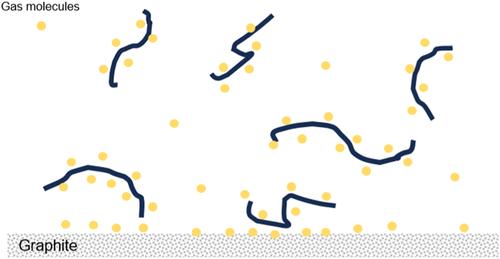支持在水溶液中疏水大分子附近的溶解空气气体富集的证据
IF 3.9
2区 化学
Q2 CHEMISTRY, MULTIDISCIPLINARY
引用次数: 0
摘要
在本研究中,我们将含有疏水(GA)15原纤维的缓冲溶液沉积在高取向热解石墨(HOPG)上,并通过原子力显微镜(AFM)对其表面进行成像。在施加环境缓冲液(未脱气)的3小时内,我们观察到在HOPG表面围绕(GA)15原纤维形成了二维条纹状结构域。然而,在脱气缓冲液下,这些条纹域不会形成。此外,在含有(GA)15原纤维的缓冲溶液中,HOPG上条纹结构域的形成比在纯缓冲溶液中要快得多。这些条纹结构最近被确定为氮气水合物层,是通过氮和水分子在HOPG表面的自组装形成的。我们的研究结果表明,气体富集发生在疏水大分子周围的界面水中。这些结果对于理解疏水相互作用和疏水纳米物体在水环境中的自组装具有重要意义。本文章由计算机程序翻译,如有差异,请以英文原文为准。

Evidence Supporting Enrichment of Dissolved Air Gases near Hydrophobic Macromolecules in Aqueous Solutions
In the present study, we deposited buffer solutions containing hydrophobic (GA)15 fibrils onto highly oriented pyrolytic graphite (HOPG) and imaged the surfaces through atomic force microscopy (AFM). Within 3 h of applying ambient (nondegassed) buffers, we observed the formation of two-dimensional stripe-like domains on the HOPG surfaces surrounding the (GA)15 fibrils. However, these stripe domains did not form under degassed buffers. Furthermore, the formation of stripe domains on HOPG occurred considerably faster in the presence of buffer solutions containing (GA)15 fibrils than in the presence of pure buffer solutions. These stripe structures have recently been identified as nitrogen gas hydrate layers, which are formed through the self-assembly of nitrogen and water molecules on HOPG surfaces. Our findings suggest that gas enrichment occurs in the interfacial water surrounding hydrophobic macromolecules. The results have crucial implications for understanding hydrophobic interactions and the self-assembly of hydrophobic nano-objects in aqueous environments.
求助全文
通过发布文献求助,成功后即可免费获取论文全文。
去求助
来源期刊

Langmuir
化学-材料科学:综合
CiteScore
6.50
自引率
10.30%
发文量
1464
审稿时长
2.1 months
期刊介绍:
Langmuir is an interdisciplinary journal publishing articles in the following subject categories:
Colloids: surfactants and self-assembly, dispersions, emulsions, foams
Interfaces: adsorption, reactions, films, forces
Biological Interfaces: biocolloids, biomolecular and biomimetic materials
Materials: nano- and mesostructured materials, polymers, gels, liquid crystals
Electrochemistry: interfacial charge transfer, charge transport, electrocatalysis, electrokinetic phenomena, bioelectrochemistry
Devices and Applications: sensors, fluidics, patterning, catalysis, photonic crystals
However, when high-impact, original work is submitted that does not fit within the above categories, decisions to accept or decline such papers will be based on one criteria: What Would Irving Do?
Langmuir ranks #2 in citations out of 136 journals in the category of Physical Chemistry with 113,157 total citations. The journal received an Impact Factor of 4.384*.
This journal is also indexed in the categories of Materials Science (ranked #1) and Multidisciplinary Chemistry (ranked #5).
 求助内容:
求助内容: 应助结果提醒方式:
应助结果提醒方式:


